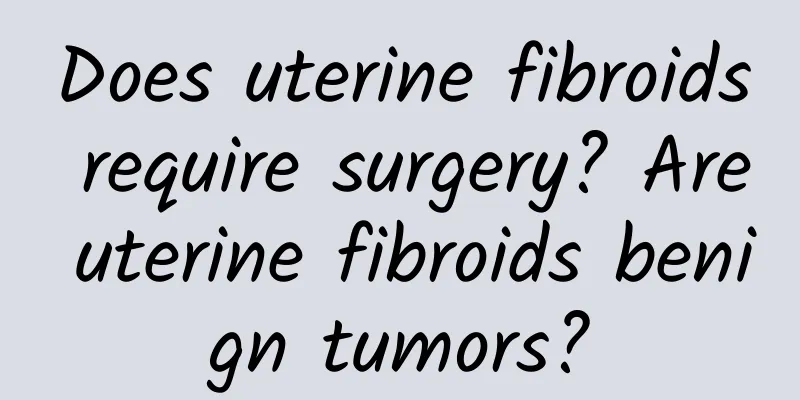Does uterine fibroids require surgery? Are uterine fibroids benign tumors?

|
Clinically, uterine fibroids fall into the category of metrorrhagia, symptoms, and stones in traditional Chinese medicine, and there are many different treatment methods. So, how many surgeries are needed for uterine fibroids? 1. Uterine fibroids are the most common benign tumors of the female genitalia and the most common tumors in the human body. They are formed by the proliferation of uterine smooth muscle tissue, which contains a small amount of fibrous connective tissue. Single or multiple. Depending on the size of the tumor and the location of growth, clinical symptoms such as menorrhagia, dysmenorrhea, leucorrhea, abdominal mass, infertility, and anemia are often present. They are more common in women aged 30 to 50, more common in women aged 40 to 50, and less common in women under 20. Its incidence is difficult to count. According to autopsy data, about 20% of women over 35 years old suffer from uterine fibroids. Since many patients have no symptoms or the fibroids are very small, the incidence reported clinically is much lower than its actual incidence. 2. Surgical treatment of uterine fibroids Generally, if a single fibroid is smaller than 2cm, it can be treated under the guidance of a doctor; if the diameter of a single fibroid is 2cm or more, it has the characteristics of surgery. If the diameter reaches 5cm, surgical treatment is indispensable. Because if the amount of bleeding or menstrual flow is heavy, the anemia time is long, and the drug cannot completely solve it, so this is the best time for uterine fibroid surgery. Common treatments for uterine fibroids include: 1. Drug treatment: mainly short-term treatment, mainly suitable for patients with uterine fibroids, to correct anemia before surgery, reduce uterine volume, avoid intraoperative bleeding, and reduce surgical difficulties; menopausal women, uterus smaller than 10 weeks of pregnancy, mild symptoms; other complications have surgical contraindications. Due to side effects, it should not be used for a long time. 2. Surgical treatment: Surgery is still the most commonly used treatment for uterine fibroids. It is mainly divided into hysterectomy and myomectomy. The surgery can be performed abdominally, laparoscopically or vaginally, depending on the size of the uterus, the location of the fibroids, pelvic and abdominal adhesions, abdominal and vaginal conditions (such as obesity, etc.), the equipment and technical conditions of the doctor and hospital. |
<<: How big is the uterine fibroid before surgery is needed? Common treatments for uterine fibroids
Recommend
Which department does Tianjin Uterine Fibroid Hospital go to? Which hospital in Tianjin is good for treating uterine fibroids?
Which department does Tianjin Uterine Fibroid Hos...
FDA: Laboratories are required to have the ability to detect 0.1ppb
In response to media reports that some scholars a...
Causes of bacterial vaginosis
The most common disease in the vagina is vaginiti...
Signs of menopause in women
Everyone is no longer unfamiliar with the disease...
What should I do if I have stomach pain after miscarriage?
What should I do if I have stomach pain after mis...
Thread embedding not only helps in body sculpting, but also has these uses. Is it suitable for everyone? A Chinese medicine practitioner answers
Summer is here, and it is the peak season for wei...
How to prevent the occurrence of endometrial thickening disease
Nowadays, diseases in life are really hard to pre...
Causes of habitual miscarriage
Many female friends are prone to miscarriage and ...
Experts explain the dietary principles for dysmenorrhea
It is very necessary to regulate the diet for dys...
Painless abortion surgery is not the sooner the better
After an unexpected pregnancy, women always think...
Losing weight is not just about eating the right foods, adjusting the order of your diet is even more critical! Stabilize blood sugar after meals and avoid obesity
If you want to lose weight easily, in addition to...
What is Bartholinitis
What is Bartholin's glanditis? This is a rela...
A girl's dream fruit! Sweet persimmons can help you lose weight and replenish blood
As fall and winter arrive, sweet persimmons are a...
Common medication misunderstandings in patients with cervical precancerous lesions
As our quality of life continues to improve, our ...
Tips: Treatment of chronic pelvic inflammatory disease
With the continuous improvement of medical standa...









